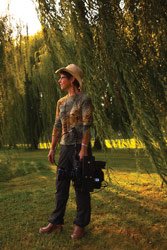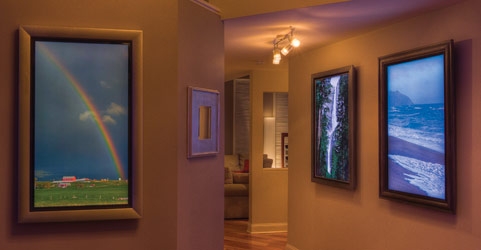“…look intently, undeterred, at a single object. Suddenly, miraculously, it will reveal itself as something we have never seen before.”
—Cesare Pavase, Italian poet/novelist
It was a vision that had been in the making for several years. “A common appreciation for stunning visuals became the impetus for conversations into the wee hours,” says Susan Rees. “These conversations turned into brainstorming sessions…Finally, the technology caught up to the ideas we had.”
Those ideas were validated in September, when Epic Eye debuted Moving Murals at the IIDEX/NeoCon Canada, an international trade show for the interior design community. Though newcomers to the scene, Rees’ firm walked away with a gold-level Innovation Award for new product design in the built environment.
A Stitch in Time
Touted as the “canvas of the future,” Moving Murals are Epic Eye’s signature product. They consist of high-definition graphics streamed to a framed LED panel, showcasing imagery ranging from landscapes and waterfalls to urban areas and abstract textures.
 Each mural is comprised of 6,000 or more photographs stitched together and looped indefinitely. With the intent of providing “a window into another reality,” images are captured at digital cinema 4K resolution and beyond. That’s 110 times greater than a standard DVD, 75 times that of traditional HD programming, and 24 times that of Blu-Ray technology—the equivalent of an IMAX-like experience in your home or business.
Each mural is comprised of 6,000 or more photographs stitched together and looped indefinitely. With the intent of providing “a window into another reality,” images are captured at digital cinema 4K resolution and beyond. That’s 110 times greater than a standard DVD, 75 times that of traditional HD programming, and 24 times that of Blu-Ray technology—the equivalent of an IMAX-like experience in your home or business.
The capture of such rich imagery—so critical to the Moving Murals concept—has only recently become feasible. With so much data flying around the web, video files must be compressed, lest the information highway slow to a crawl. But when it comes to quality, a high price is paid for that mobility. “It loses the very characteristics that enable it to move people,” according to Epic Eye. And it’s the ability to move people that’s at the heart of this new venture.
A Family Affair
Following years of experience in financial services, Susan Rees describes her role at the helm of Epic Eye as the pinnacle of her career. Not only does it unite her knack for business with a passion for the arts, it’s also an opportunity to work closely with her multi-talented family.
Her son, Aaron Rees, shoots the images, performs complex processing and handles the R&D necessary to keep up with the latest technologies. Her daughter, Sarah Christensen, also shoots images and manages operations. Together, the two siblings ran a successful photography/videography company before selling it last February to join their mother in launching Epic Eye.
Rees’ husband, Lem, performs carpentry work for the handcrafted custom frames, while two of her nephews compose ambient music for the murals. The team is rounded out by another shooter, Clayton Price, and installer Kris Krancher.
 Inspiration Everywhere
Inspiration Everywhere
Epic Eye’s unique treatment is applied to a cornucopia of aesthetic wonders. Waves crash on ocean rocks, tree branches sway in the breeze, a herd of cattle wag their tails while grazing. “We get a lot of satisfaction from the diversity of our subject matter,” says Rees.
Ideas can come from anywhere. “A single amazing photograph often inspires us,” she explains. “Sometimes, you are simply ambushed by a striking scene, and you pull off the road in hopes that you’ve happened upon some gold.”
But the challenges are steep when a single miscalculation or omission of a seemingly trivial step can ruin an entire day’s shoot. And then there’s the weather. “Because we have to hold a composition anywhere from 15 minutes to 12+ hours, we rely on favorable conditions extending for large windows of time,” says Rees. “And you can’t control Mother Nature. You simply have to be prepared for everything so you can take advantage of the moments when magic materializes.”
And that magic is the central aim, no matter the subject. “My absolute favorite scenes,” adds Rees, “are the ones where the entire team had to pull together to even have a chance at capturing something special. Knowing what it took to make a hard-won scene come to life is an unrivaled feeling.”
Moving Forward
On the heels of its award-winning debut just a few months ago, the Epic Eye team is excited for the future. “And we haven’t even had the opportunity yet to present our company to a large audience in the U.S.,” notes Rees. “That will come in the first quarter of 2012.”
Having had success placing murals in residential settings, the firm has a number of notable projects in the planning stages. A custom home builder wants to place two Moving Murals in a model home in Toronto. An architectural firm is including them in its proposal for a LEED-certified restoration of an historic building in Denver. And several feng shui masters are considering them as water features, which could meet their design objectives without the upkeep involved with actual running water.
The company is also working on a custom piece for a business that wants to combine art and advertising. “We are developing some prototypes of murals with intermittent brand messaging,” says Rees. “In corporate lobbies, the art can stand alone, but there is additional return on investment if an appropriately spaced communication can help promote a business objective.” She also envisions the use of Moving Murals in healthcare facilities and at charitable organizations—wherever patients and families would benefit from therapeutic art.
For more information on Moving Murals—or to watch them in action—visit epiceye.com. a&s


